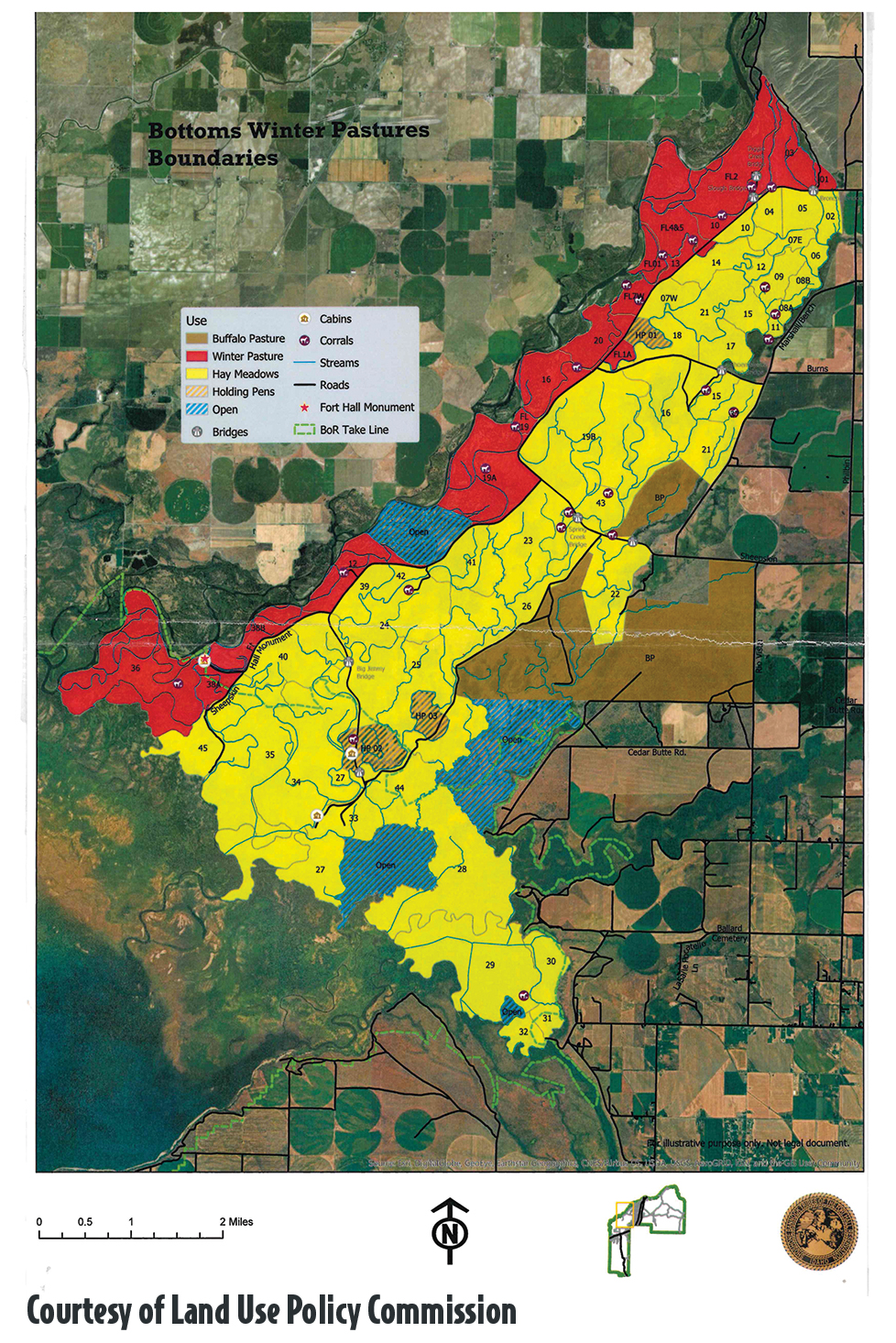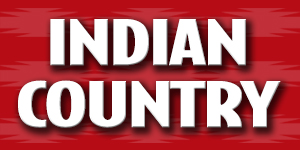Sho-Ban Tribes LUPC implements new guidelines for Fort Hall Bottoms

Bottoms winter pasture boundaries map.
By LORI ANN EDMO
Sho-Ban News
FORT HALL — Shoshone-Bannock Tribes Land Use Policy Commission has implemented new guidelines for the Fort Hall Bottoms that will limit the number of horses, cattle and buffalo in the area because of overgrazing and the need to restore the natural resources.
The Bottoms consists of 25,500 acres of tribal land that runs along the Snake River on the western edge of the Fort Hall Indian Reservation. Currently there are 22 feedlots or winter pastures located there where tribal member ranchers keep there cattle. The Tribes buffalo herd roam on the Bottoms, along with upwards of 800 horses that are mostly feral.
The Fort Hall Business Council approved resolution LAND-2022-0898 October 25, 2022 that reads recent changes in the climate, impacts to natural resources outlines in the Tribes Tributary Assessment and studies based on forage availability in the Bottoms show impacts to natural resources within the Bottoms. The last 22 years have shown trends in increased temperature, longer drought periods, overgrazing and major fire events result in management changes that have to be addressed to protect natural and cultural resources. The resolution reads that Tribes have invested millions of dollars in protecting, remediating and monitoring impacts to the Bottoms terrestrial and aquatic habits for Fish and Wildlife.
Because the Fort Hall Reservation is the permanent homeland of the Shoshone-Bannock Tribes forever, the LUPC believes it must be taken care of for the long term. As a result they’re implementing certain guidelines in areas used by hay meadow and winter pasture permittees, along with other users.
Effective October 1 and ending September 30, 2026, hay meadow and winter pasture permits will be issued for a three year period. Livestock caps will be implemented including:
• 1,800 cattle on the Fort Hall Bottoms or as designated by the LUPC.
• 250 cattle per individual and no more than 400 cattle per feed lot. The first l00 cattle will be approved for each individual applicant until the 1,800 cattle cap is met. If there are leftover numbers under 1,800, it shall be divided equally among the remaining operations. If there are more than 1,800 cattle among all applicants at the 100 per person, the number will be divided equally.
• No more than 30 horses shall be approved for any one Tribal Member and no more than 200 horses shall be permitted total. Every horse is required to follow the same time guidelines as cattle.
• No more than 250 buffalo shall be permitted at one time on the Fort Hall Bottoms. Over the next 3 years this number should be trending toward I00 buffalo.
These caps can only be changed by written authorization of the Land Use Policy Commission.
Currently at least three tribal ranchers on the south end of the Bottoms could exceed the proposed numbers and commissioners are assisting in finding other potential pastures. Concerning the tribal buffalo, commissioners said some could move to land in Bannock Creek.
LUPC Chairperson Laurie Kniffin said all existing feed lot and hay meadow permittees were mailed letters notifying of the change. In addition, LUP Commissioners are attending reservation district meetings in January.
Applications are being accepted through the end of February for hay meadows and winter pastures. Tribal members who live on the rez must own at least 25 head of livestock bearing an up-to-date brand card registered with the State of Idaho in the name of the permittee. The resolution reads only livestock bearing the registered brand of a Tribal member will be allowed to utilize the Bottoms hay meadow and winter pastures. If ownership is in question, the application will be denied. If livestock are found on the Fort Hall Bottoms that do not have a Tribal member brand, they will be impounded immediately. The member must prove they own the cattle or have the ability to own cattle as determined by the Land Use Policy Commission;
Every effort shall be made to cut out and separate non-Indian cattle coming off the summer range prior to reaching the Bottoms area in compliance with Range Permit requirements and Tribal Brand Inspector/Compliance officer counts;
At any point in the assignment period, the Land Use Policy Commission can make the decision to restrict access folly to non-member owned cattle and it will be the responsibility of owners to separate cattle before going to the Fort Hall Bottoms.
Non-Indian cattle from summer range may be allowed to graze in the Fort Hall Bottoms with written permission from the Land Use Policy Commission but will be assessed AUM's during fall roundup and an environmental impact fee of $5 per head. AUM's will be billed at the fair annual rental rate established during the contract period and botl1 fees will be paid to the Spring Creek Development Fund.
Concerning new permittees, the guidelines read tribal members must own at least five head of livestock or more and have proper brand regulation.
Only approved permittees will be allowed to harvest hay and feed their livestock within the Fort Hall Bottoms. Feeding of livestock must be 100 feet away from any spring, creek, or river, Failure to comply may result in environmental damage fees set by the Land Use Policy Commission {no more than $50 per instance). Any deviation from this guideline must be obtained by the Land Use Policy Commission in writing.
Any hay meadow areas not harvested on or before September 6 shall be left for wildlife and no hay meadows can be cut after that date.
If a tribal member moves off the reservation during the permit period that member will lose their assignment.
Regarding non-Indian cattle coming off the summer range, every effort should be made to cut out and separate them prior to reaching the Bottoms in compliance with range permit requirements and tribal brand inspection or compliance officer counts. LUPC can decide to restrict access to non-member owned cattle and it’s the responsibility of owners to separate cattle before going to the Fort Hall Bottoms.
Concerning crop sharing, harvested hay shall not be sold, traded or harvested on a crop share basis. Failure to comply could result in a loss of assignment for remainder of the assignment period and may make the individual ineligible to receive an assignment in the future.
Trespass permits – non tribal members working or accompanying a permittee into the Bottoms will be required to obtain an approved trespass permit each year. Non member custom harvesting will also be required to secure a trespass permit from the Land Use Department prior to entering the Fort Hall Bottoms.
Debris – permittees are required to keep their hay meadow or winter pasture and all areas of the Bottoms clean and free from all twine, wire and debris at all times. All waste must be disposed of properly from the Bottoms and failure to comply could result in an environmental imipact fee determined by the LUPC (not more than $200 per instance.)
Disposing dead animals – it is the sole responsibility of livestock owners to immediately dispose of dead livestock. Failure to comply could result in an environmental impact fee determined by the LUPC.
Improvements - no fences or structures shall be constructed in the Bottoms area except in the repair and maintenance of existing fences and structures in approved winter pastures. Any fence or structure that may be considered new shall only be allowed by the written permission of the Land Use Policy Commission for the protection of natural resources such as water ways, sensitive vegetation. or springs;
Padlocks are not permitted in the Bottom areas(s); the only exception will be in the Buffalo Pasture Area(s). Unauthorized padlocks will be removed;
Temporary fences erected by Natural or Cultural Resource Departments shall be permitted;
Such fences shall be constructed for the purpose of protecting environmental concerns, such as habitat protection, erosion control, spring and stream protection and Cultural Resources;
Temporary fences may be erected to protect individual hay stacks.
Horses – horse owners are responsible for caring for and feeding while pasturing on the Bottoms areas and begin reducing individually owned herd to a manageable number. LUPC sets acceptable rates based on pasture assignments. Ordinance 704 Abandoned or Uncared for Animals/Cruelty to Animals section will be enforced. Unclaimed horses and unbranded horses 2-years old and older will be sold at auction and profits will be paid to the Spring Creek Development Fund.
Burn permits – burn permits issued on a case-by-case basis. Burning of hay meadows is restricted from October 1 through May 1 each year unless otherwise determined by the LUPC. Burn areas are in hay meadows or winter pasture containing wild hay only. Permittees shouldn’t burn cattails, bull brush, willows, rosebushes and trees without written permission from the LUPC. Misuse of natural habitat, hay meadow or winter pasture guidelines will result in permit cancellation.
Deceased permittees - Upon the death of a permittee, the immediate family member(s) or individuals that appear on the application may apply for the hay meadow and winter pasture and must meet the eligibility requirements. First preference is given to the immediate family. If the immediate family is ineligible or has no interest in applying, the LUPC will declare the hay meadow or winter pasture open for applications.
Enforcement – the Livestock ordinance is in effect and enforced in all areas within the exterior boundaries of the Fort Hall Reservation and offenses will be cited.
Liability – the Tribes aren’t responsible for lost, stolen or damaged hay, livestock or property.
Kniffin said hay meadow and winter pasture permittees will be selected in early May and priority is given to existing permittees.





